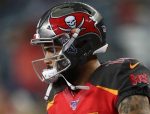Tom Brady still learning role ahead of Buccaneers’ season opener

Brady has found that he’s had to do a lot more thinking and that things might not be second-nature for him the way they were after 20 seasons with the New England Patriots. At times, he has even gone to the line of scrimmage and caught himself making a check with Patriots’ verbiage instead of Bucs’ verbiage.
“I think there’s naturally a way that, your body just does things a certain way that it’s done for a long time, without you having to think, and a lot of being a great athlete is not thinking, so the more you’re thinking, it’s actually slower than if you were just reacting and anticipating,” Brady said. “So we’re working through that. It’s my first game, my first chance to play so, we’ll see where we’re at. We’ve got a big test and… there’s no room for error. It’s a big challenge to start the year.”
Brady has faced the Saints five times in his career and gone 4-1, most recently with a 36-20 victory at the Superdome in 2017, where he threw for 447 yards, three touchdowns and no interceptions. But the Saints’ defense has continued to improve since then and they’ve had a firm hold on the NFC South, winning the division the past three years.
“It’s a big challenge because there’s no margin of error when you play a great football team,” Brady said. “The Saints have proven themselves to be that for a long time. They [have] a very good offense, a great defense, they’re very well-prepared [and] they don’t beat themselves.”
During the Bucs’ team scrimmages, Brady was getting in the calls quickly, but encountered challenges with artificial crowd noise and not being able to read coaches’ lips due to face masks. They also didn’t have the benefit of preseason games to rehearse certain elements of situational football.
“The processes that we go to, how to prepare on first down, second down, [and] third down, in the red zone, all the different situations that come up — we’re talking about them for the first time and it’s not a preseason game,” Brady said. “I think those things are important and they’re an important part of the process, but we just didn’t have them this year.”
Offensive coordinator Byron Leftwich called the offense a “blank canvas” that they’re still creating. They’ve incorporated certain concepts that Brady utilized successfully in New England — a renewed commitment to running the ball and lots of screen passes mixed in with deep shots off play-action. They’ve blended them with Bruce Arians’ “No risk it, no biscuit” offense into something Brady says he feels comfortable with.
“It will grow as we go, but he’s a smart guy,” said Leftwich, who played quarterback in the NFL for 10 seasons. “We’ve had enough time to add a lot of that into our game plan where he can continuously put us in the best position to make plays. We’ve had enough time for that. Obviously, it will get better as the year goes on, and I believe that’s with every team. Every team we’re playing, we’re using the same time, we’ve all been short on time. There will be some of those things in our offense where he has full control over everything. He has full understanding of everything, so there will be some [changes at the line of scrimmage], but it will get more expansive as we get through the season.”
He’s still building trust and chemistry with 1,000-yard receivers Mike Evans — whose game status is in jeopardy because of a hamstring injury — and Chris Godwin, along with youngsters Scotty Miller and Justin Watson. There also are tight ends O.J. Howard and Cameron Brate and running backs Ronald Jones, LeSean McCoy and newcomer Leonard Fournette.
He does have the benefit of Rob Gronkowski, who’s 78 career touchdowns from Brady are the most of any target in the 43-year-old passer’s career. But he also has had to learn a new system.
“We’re gonna learn a lot over the course of the season,” Brady said. “The only thing you’ve got is today, to learn from today, and our practice today, what we did, what we didn’t do right, and then try to correct it for tomorrow, and then we’re gonna play a game. And we’re gonna figure out what we’re good at and what we’re not good at. I wish we knew those things right now, but I think the reality is, we don’t know what we’re very good at, we don’t know what we’re not good at. But we’re gonna try some things and we’re gonna see how it looks under real competition.”
He added, “You don’t know it until you go do it. Everyone can hypothesize and predict and so forth, but we get a chance to go out there and do something about it.”